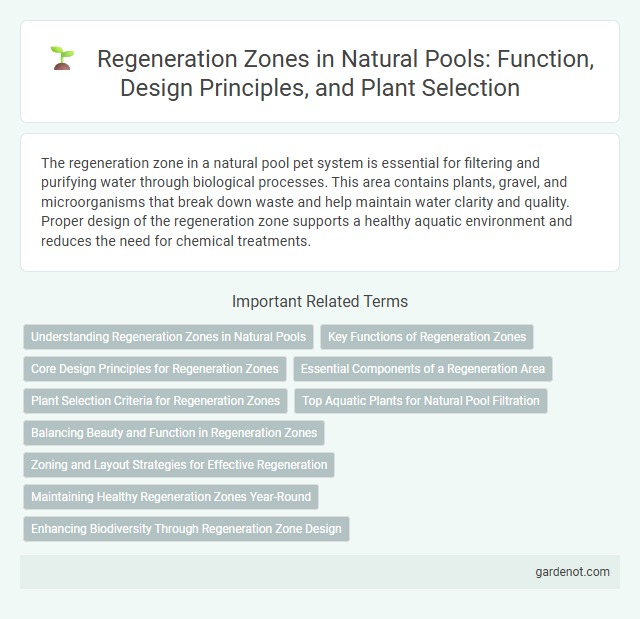The regeneration zone in a natural pool pet system is essential for filtering and purifying water through biological processes. This area contains plants, gravel, and microorganisms that break down waste and help maintain water clarity and quality. Proper design of the regeneration zone supports a healthy aquatic environment and reduces the need for chemical treatments.
Understanding Regeneration Zones in Natural Pools
Regeneration zones in natural pools function as critical biological filters where aquatic plants and microorganisms remove pollutants, promoting water clarity and balance. These zones harness processes such as nutrient uptake and sediment settling, which reduce algae growth and enhance oxygen levels. Proper design and maintenance of regeneration zones ensure sustainable water quality and support diverse aquatic ecosystems.
Key Functions of Regeneration Zones
Regeneration zones play a critical role in natural pools by filtering impurities and maintaining water clarity through biological processes. These zones utilize aquatic plants and microbial activity to absorb excess nutrients and break down organic matter, preventing algae growth and improving water quality. Their function supports a balanced ecosystem, ensuring sustainable water circulation and healthy habitat conditions for aquatic life.
Core Design Principles for Regeneration Zones
Regeneration zones in natural pools prioritize biological filtration by maximizing plant density and substrate diversity to enhance water purification. Core design principles include creating shallow areas with native aquatic vegetation that support beneficial microorganisms and facilitate nutrient uptake. Effective zoning balances habitat variety and hydraulic flow to maintain water clarity and ecosystem health.
Essential Components of a Regeneration Area
A regeneration zone in a natural pool requires a combination of porous substrate, aquatic plants, and continuous water movement to filter and purify water effectively. Essential components include gravel or sand beds that provide surface area for beneficial bacteria to break down waste, alongside macrophytes such as reeds and water lilies to absorb nutrients and oxygenate the water. These elements work synergistically to maintain water clarity and ecological balance without chemical treatments.
Plant Selection Criteria for Regeneration Zones
Plant selection criteria for regeneration zones in natural pools prioritize native species with high nutrient uptake efficiency to enhance water purification. Plants should possess robust root systems for substrate stabilization, tolerate fluctuating water levels, and support biodiversity by providing habitat for aquatic organisms. Emphasis on species such as cattails, water lilies, and sedges ensures effective filtration and ecological balance within the regeneration zone.
Top Aquatic Plants for Natural Pool Filtration
The regeneration zone in a natural pool relies heavily on top aquatic plants such as water lilies, cattails, and hornwort, which play a crucial role in filtering and purifying the water. These plants absorb excess nutrients, reduce algae growth, and provide habitat for beneficial microorganisms that enhance water clarity. Effective natural pool filtration depends on a balanced diversity of these aquatic plants to maintain ecological stability and water quality.
Balancing Beauty and Function in Regeneration Zones
Regeneration zones in natural pools play a crucial role in maintaining water purity by leveraging plants and substrate to filter out impurities effectively. Balancing aesthetic appeal with functional design ensures that these zones integrate seamlessly into the landscape while supporting biodiversity and enhancing water quality. Optimizing plant selection and spatial arrangement maximizes nutrient uptake and habitat creation, promoting a sustainable aquatic ecosystem.
Zoning and Layout Strategies for Effective Regeneration
The regeneration zone in a natural pool is strategically designed to maximize water purification through plant-based filtration and microbial activity. Effective zoning separates the swimming area from the regeneration zone, optimizing flow dynamics and ensuring contaminated water is naturally treated before recirculation. Layout strategies emphasize shallow planting beds with diverse aquatic vegetation to enhance nutrient uptake, oxygenation, and sedimentation, creating a balanced ecosystem that sustains water clarity and ecological health.
Maintaining Healthy Regeneration Zones Year-Round
Maintaining healthy regeneration zones in natural pools involves ensuring optimal water circulation and supporting diverse aquatic plants that filter impurities and stabilize sediment. Seasonal monitoring of nutrient levels and debris accumulation prevents algae overgrowth and promotes balanced microbial activity critical for water clarity. Implementing organic mulching and regular plant trimming sustains nutrient absorption, fostering a robust ecosystem that naturally regenerates year-round.
Enhancing Biodiversity Through Regeneration Zone Design
The regeneration zone in a natural pool plays a crucial role in enhancing biodiversity by providing a habitat for diverse aquatic plants and microorganisms. This area supports water purification and oxygenation, fostering a balanced ecosystem that attracts amphibians, insects, and beneficial wildlife. Thoughtful design of the regeneration zone maximizes biological filtration and creates a thriving environment that sustains the natural pool's ecological health.
Regeneration zone Infographic

 gardenot.com
gardenot.com